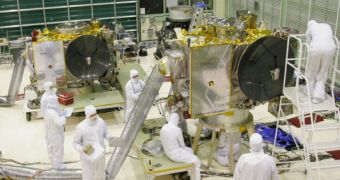Astronomers with the American space agency announced yesterday that they began receiving the first images sent by the Solar TErrestrial RElations Observatory (STEREO) mission, consisting of two nearly-identical spacecrafts that orbit around the Sun and provide stereoscopic images of the star. Experts at NASA are now literally glued to their monitors, processing every bit of information in real time. The excitement within the scientific community is massive at this point, because finally more than three fourths of the Sun's surface can be observed at the same time.
"This is a perspective we've never had before. We're now monitoring more than 270 degrees of solar longitude – that's 3/4ths of the star," shares Lika Guhathakurt, a scientist for the STEREO mission from NASA's headquarters. "After all these years we're finally getting to see the dark side of the sun."
One of the main goals of this mission, launched on October 25th, 2006, is to create a monitoring network that can supply data about solar storms and radiation 24/7. The entire surface of the Sun is visible from Earth at designated times, but researchers have thus far had no effective means of studying all of it at once, even through indirect measurements. Analyzing what goes on behind the star and seeing what happens in front of it could potentially help astronomers develop new estimates of the Sun and better assess its future threats.
At this moment, the star is at its lowest point in the 11-year cycle, but soon it will start getting stronger, which means that more sunspots and solar flares will become visible and the STEREO system will have a lot to do. Coincidentally, around 2011-2012, the probes will have reached their optimum observation positions, after which they will slowly drift apart and will send back irrelevant data until their demise.
Both STEREO A and B are equipped with large arrays of sensors, capable of detecting the speed, direction and composition of the solar wind. Because of its position, STEREO-B has a three-day head start in observing solar storms or mass coronal emissions, meaning that it could warn Earth some 72 hours before the portion of the Sun exhibiting them turns to face us.

 14 DAY TRIAL //
14 DAY TRIAL //